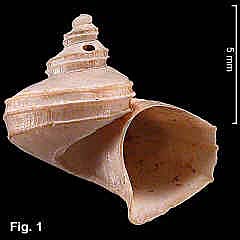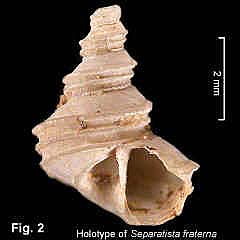|
|
|
|
|
Separatista helicoides (Gmelin, 1791) Description: Protoconch of 1 smooth whorl, with sudden transition to strongly sculptured teleoconch. Spire whorls rounded and axially elongated at first, becoming angled and axially compressed on latter whorls; smooth on shoulder, 2 strong cords on periphery. Axial sculpture absent. Last whorl with 3 spiral cords on periphery; base smooth, edged by broad, low cord surrounding umbilicus; last part of whorl detached. Umbilicus wide, deep. Aperture with inner and outer lips thin, crenulated by external sculpture. Colour fawn. Periostracum fawn, with axial lamellae on periphery and spines on shoulder. Size: Up to 15 mm high. Distribution: Indo-West Pacific. In Australia, known from all states except Tasmania. In NSW, known from only one juvenile specimen Habitat: Lives on fan worms in intertidal, rocky habitats (Okutani, 2000, pp. xx, 196). Coleman (1981) figured a specimen with egg capsules attached to a worm tube. Rare in NSW. Synonymy: Previously established synonyms are Turbo separatista Dillwyn, 1817; Trichotropis blainvilleanus Petit, 1851; Trichotropis tricarinata Brazier, 1877. Specimens from Victoria were named Trichotropis gabrieli Pritchard and Gatliff, 1898, but those authors subsequently recognized their name as a synonym of Trichotropis blainvilleanus Petit, 1851, which is itself now a synonym of S. helicoides. Examination of Victorian specimens in the Australian Museum collection show them to be conspecific with S. helicoides, so Trichotropis gabrieli is placed into the synonymy of this species (NEW SYNONYM). Specimens from South Australia were recognized as Lippistes separatista Dillwyn, 1817, a synonym of S. helicoides, by Verco (1906). Examination of a South Australian specimen in the Australian Museum confirms it as that species. Examination of the type of Separatista fraterna Iredale, 1936 (Fig. 2) shows it to be a juvenile specimen of S. helicoides (NEW SYNONYM). Remarks: The range of this species is given in the standard works (e.g. Okutani, 2000) as Indo-West Pacific. Species of Indo-West Pacific distribution that occur in northern Australia reach down the west coast and the east coast to temperate waters, commonly with a limit of south-western WA on the west coast and Sydney on the east coast. The present species is unusual in reaching South Australia and Victoria, with only one record from NSW. Fig. 1: 4042-1 Western Port, Victoria (C.012908) Fig. 2: 4043-1 Holotype of Separatista fraterna. North Harbour, Sydney (C.144464) |

